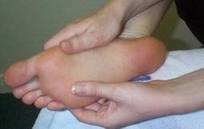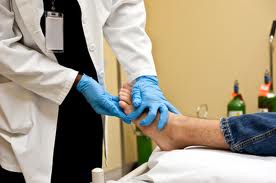 November is American Diabetes Month. According to the 2011 National Diabetes Fact Sheet published by the Centers of Disease Control and Prevention, diabetes affects 25.8 million people in the U.S. – that’s 8.3% of the population.
November is American Diabetes Month. According to the 2011 National Diabetes Fact Sheet published by the Centers of Disease Control and Prevention, diabetes affects 25.8 million people in the U.S. – that’s 8.3% of the population.
People with diabetes can develop many different foot problems, including calluses and foot ulcers. These foot problems are often the result of neuropathy (nerve damage which causes you to lose feeling in your feet) or poor circulation due to the blood vessels narrowing and hardening in the leg and foot. Unfortunately, foot ulcers and infections in people with diabetes may lead to amputation. However, most amputations are preventable with regular foot care and proper footwear.
To prevent serious foot problems from occurring, follow these simple steps:
- Visit your doctor at least once a year for a complete foot exam, including checking for skin, muscle, bone, circulation and nerve issues.
- At every doctor appointment, have your doctor examine your feet.
- See your doctor immediately if you have any foot problems, such as cuts, changes in skin color or foot shape, sensitivity issues, or pain. Have your doctor take care of any corns or calluses, as well as trimming your toenails if you cannot trim them safely yourself.
Proper Foot Care
- Keep your blood glucose within your target range.
- Plan a physical activity program with your health care team and keep active.
- Check your feet every day for redness, cuts, sores, swelling, blisters, calluses, and ingrown toenails. If you have difficulty seeing your feet, use a mirror or have someone else check your feet for you. Examine the tops, bottoms and sides of your feet as well as your toes. Use your hands to feel for hot or cold spots, bumps or dry skin.
- Wash your feet every day with warm (not hot) water and soap. Don’t soak your feet. Dry your feet thoroughly with a soft towel, especially between your toes.
- If the skin on your feet is dry, apply a thin coat of lotion after you wash and dry them. However, don’t apply lotion between the toes since extra moisture in this area may lead to an infection.
- If you can safely trim your toenails, trim them once a week or as needed. Cut them straight across and round the edges with a nail file to prevent ingrown toenails.
- Always wear socks and shoes, even around the house, to protect your feet from injury. Never walk barefoot, even at the beach or pool.
- Don’t wear socks that irritate your feet or are too tight. Choose seamless socks or those with flat or soft seams. Many companies make socks especially for diabetics. If your feet are at high risk for ulcers or irritations, you should wear white socks and look at the inside of them when you take them off to check for signs of bodily fluids. Some diabetic feet will weep prior to an ulcer erupting.
- Protect your feet from heat and cold. Wear shoes at the beach or on hot pavement. Test bath water before putting your feet in it. Wear insulated boots to keep your feet warm and dry during rainy or winter weather.
- Wear comfortable, properly fitted shoes that protect your feet. Refer to our Shoe Fit Guidelines on how to properly fit your shoes. Check the insides of your shoes to make sure there aren’t any rough edges or pebbles in them before you put your shoes on. Make sure your shoes are adjustable to accommodate the possibility of swelling.
- Ask your doctor about wearing special shoes or custom orthotics like the ezWalker® Performance Insole. For individuals with diabetes, a custom orthotic with accommodating support is recommended, especially for those suffering with neuropathy or poor circulation. An accommodative orthotic is designed to reduce pressure and prevent excess friction on the foot that can lead to skin ulcers. If you suffer from any foot deformities, such as hammertoes or bunions, an accommodative orthotic is also recommended to relieve pain and avoid further foot damage. While you may use a custom accommodative orthotic to treat foot ulcers, it is best to heal the ulcer first. A medical boot or modified shoes may be necessary during the healing process. Contact your doctor if you have any questions.
The biomechanics of your feet can affect your risk for foot ulcers. By following these foot care steps, you may save your feet from unnecessary infection and possible amputation in the future. A custom orthotic like the ezWalker® Performance Insole can provide your feet with better protection by guiding them into a more desirable biomechanic position. This will help to unload unwanted pressure on the bottoms of your feet. Plus, by relieving your foot pain, you’ll stay more active which can improve your blood glucose control.
For more information on ezWalker® Performance Insoles, visit our website. We offer a 90-day money-back guarantee, so you have nothing to lose but your foot pain. Try them today!
Note: If you follow these guidelines and your pain or foot problems persist, you may have a more serious condition. See your physician for a more complete diagnosis and treatment.


